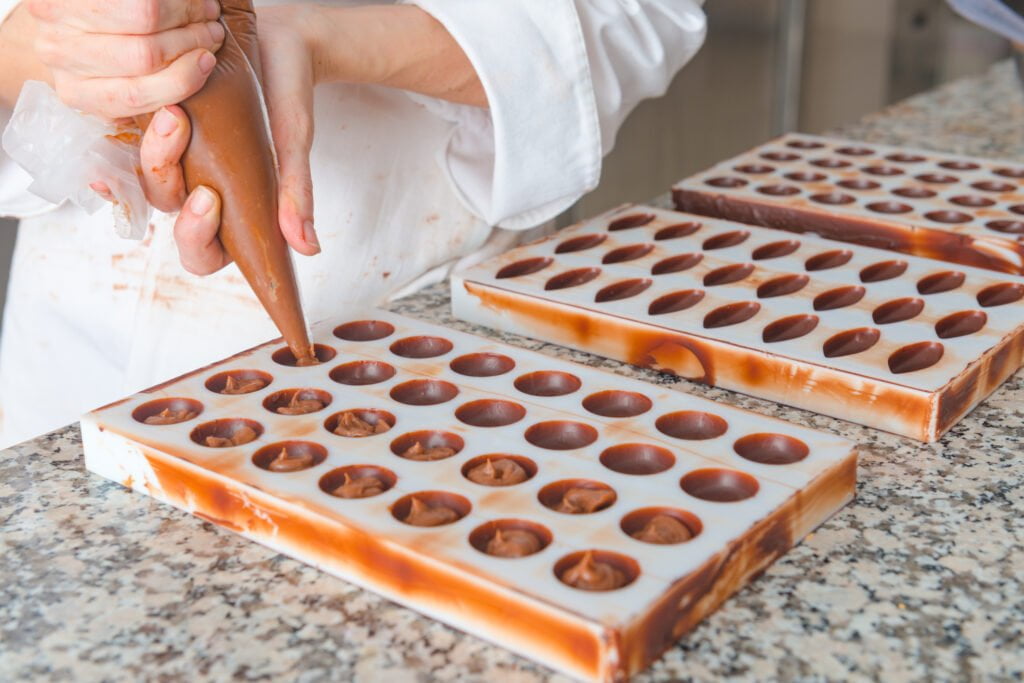If you’re a chocolate lover, you might be curious about how chocolate is made from scratch. In this article, we’ll take you through crafting chocolate by hand, from selecting the perfect cacao beans to producing the smooth, velvety chocolate bars we all know and love.
The Journey Begins with the Bean Selection
Crafting chocolate from scratch starts with selecting the right cacao beans. Beans from different regions have unique flavor profiles, so chocolate makers often source beans from multiple locations to create blends with distinctive flavors. Some chocolate makers prioritize working with small-scale farmers who can provide high-quality beans that support sustainable agriculture practices.

Fermenting the Beans
After selecting the cacao beans, the next step is to ferment them. Fermentation is a critical step in developing the chocolate’s flavor profile. During this process, the beans are placed in a container and left to ferment for several days. The heat generated by the fermentation process helps to break down the pulp around the beans, releasing the beans’ characteristic flavors.
Drying and Roasting the Beans
Once the beans are fermented, they need to be dried and roasted. This step helps to develop the chocolate’s flavor and aroma. The beans are typically spread out in the sun to dry, which can take several days. After drying, the beans are roasted to bring out the complete flavor profile. Roasting temperatures and times vary depending on the chocolate maker’s preferences.
Grinding and Conching
After roasting, the beans are ground into a fine paste called chocolate liquor. This liquor is then processed in a conching machine, which mixes and heats the chocolate to develop its texture and flavor. Conching can take several hours or days, depending on the desired result.
Tempering the Chocolate
Tempering is the process of heating and cooling chocolate to a specific temperature range to ensure that it sets correctly and has a smooth texture. This step is essential for producing high-quality chocolate bars that snap when broken and appear shiny. Tempering is a precise process; chocolate makers often use specialized equipment to achieve consistent results.
Molding and Packaging
Once the chocolate has been tempered, it can be molded into bars or other shapes. The tempered chocolate is poured into molds and left to set. After the chocolate has been established, the bars are removed from the molds and packaged for sale.
Crafting chocolate by hand is a labor-intensive process that requires skill, patience, and attention to detail. However, the result is genuinely unique chocolate full of flavor. By selecting high-quality beans, carefully fermenting and roasting them, and using precise techniques to temper and mold the chocolate, chocolate makers can produce bars as beautifully as they are delicious.
The Benefits of Hand-Crafted Chocolate
There are many benefits to choosing hand-crafted chocolate over mass-produced chocolate. For one, hand-crafted chocolate typically uses higher-quality ingredients, which results in a richer, more complex flavor. Additionally, many hand-crafted chocolate makers prioritize sustainable and ethical sourcing practices, ensuring that the chocolate is produced in an environmentally responsible and socially conscious manner.
The Future of Hand-Crafted Chocolate
As consumers become more interested in where their food comes from and how it’s made, the demand for hand-crafted chocolate will likely continue to grow. With more and more chocolate makers focusing on sustainability and ethical sourcing, we can expect to see a wider variety of unique and delicious hand-crafted chocolate bars on the market.
Research Ideas
To learn more about the history of chocolate making and the different types of cacao beans, you can explore online forums and blogs dedicated to chocolate making. You might also consider attending a chocolate-making workshop or visiting a local chocolate factory to see the process firsthand. Additionally, there are many books and documentaries that explore the world of hand-crafted chocolate, providing insight into the skill and dedication required to produce this beloved treat.

Tips for Enjoying Hand-Crafted Chocolate
To fully appreciate the flavors and textures of hand-crafted chocolate, you can do a few things to enhance your experience. First, taste the chocolate in a quiet space where you can focus on the flavors and aromas. Take small bites and let the chocolate melt slowly in your mouth to experience the flavor profile’s nuances fully. Finally, pair your chocolate with a complimentary beverage, such as a rich, full-bodied red wine or a strong espresso.
Conclusion
Crafting chocolate by hand is a complex and rewarding process that results in chocolate bars with unique flavor profiles and textures. By carefully selecting high-quality beans, fermenting and roasting them to perfection, and using precise techniques to temper and mold the chocolate, chocolate makers can produce bars as beautifully as they are delicious. Whether you’re a chocolate connoisseur or simply a fan of this sweet treat, hand-crafted chocolate is a delight for the senses that is sure to satisfy your cravings.
FAQs
Q: What is the difference between hand-crafted chocolate and mass-produced chocolate?
A: Hand-crafted chocolate is made in small batches using high-quality ingredients and traditional techniques. On the other hand, mass-produced chocolate is made using large-scale industrial processes and often includes additives and preservatives to extend shelf life.
Q: Is hand-crafted chocolate more expensive than mass-produced chocolate?
A: Hand-crafted chocolate can be more expensive than mass-produced chocolate due to the higher cost of ingredients and the labor-intensive nature of the production process. However, many chocolate lovers feel that the unique flavors and textures of hand-crafted chocolate are worth the extra cost.
Q: How can I tell if a chocolate bar is hand-crafted?
A: Look for information on the packaging or website of the chocolate maker that indicates that the chocolate is hand-crafted. Many hand-crafted chocolate bars will also have a unique appearance, distinct texture, and glossy sheen.
